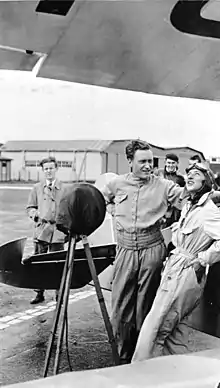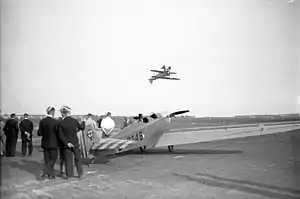Gerhard Fieseler
Gerhard Fieseler (April 15, 1896 – September 1, 1987) was a German World War I flying ace, aerobatics champion, and aircraft designer and manufacturer.
Gerhard Fieseler | |
|---|---|
 Gerhard Fieseler at the Aerobatic Championship, Berlin-Tempelhof 1931 | |
| Born | April 15, 1896 Glesch |
| Died | September 1, 1987 (aged 91) Kassel |
| Allegiance | Germany |
| German Army | |
| Unit | Feldflieger Abteilung (Field Flier Detachment) 243 |
| Battles/wars | World War I |
| Awards | Military Merit Cross |
| Other work | Flying ace, aerobatics champion, and aircraft designer and manufacturer |

From birth to the 1918 armistice
Fieseler was born in Glesch. He joined the Air Service of the German Army in 1915. Despite a crash during training hospitalizing him until February 1916, he was assigned as an observation pilot by October 1916, flying first with Feldflieger Abteilung 243, then with Feldflieger Abteilung 41. In 1917, he qualified as a fighter pilot and was posted on 12 July to the Macedonian front, initially flying a Roland D.II with Jagdstaffel 25. Fieseler scored his first aerial victory on 20 August 1917. A serious illness removed him from active duty from 21 September until 5 November 1917.[1]
Fieseler would not score his second success until 30 January 1918. He was eventually credited with nineteen confirmed aerial victories, with three others unconfirmed. Commissioned in October 1918, he was the highest-scoring German ace on the Eastern Front to survive World War I. He was awarded the Golden Military Merit Cross and the Iron Cross, first and second class.[1]
Between the World Wars
Following the war, he returned to printing, but yearned to return to flying. In 1926, he closed his print shop in Eschweiler and became a flight instructor with the Raab-Katzenstein aircraft company in Kassel and continued to hone his flying skills, becoming an accomplished stunt pilot. In 1927, he performed a particularly daring routine in Zürich and started to command increasingly high fees for appearances. In 1928, he designed his own stunt plane, the Fieseler F1, built by Raab-Katzenstein. He also designed Raab-Katzenstein RK-26 Tigerschwalbe aircraft in the end of the 1920s which was offered and sold to a Swedish company called AB Svenska Järnvägverkstäderna (ASJ), which built 25 of the type for Swedish Air Force in the beginning of the 1930s.
In 1930, Raab-Katzenstien was bankrupt, and Fieseler decided to strike out on his own. Using money he had been saving from his aerobatics, he bought the Segelflugzeugbau Kassel sailplane factory and renamed it Fieseler Flugzeugbau. Although he continued with some sailplane manufacturing, from 1932, he set up to start manufacturing sports planes of his own design. In one of these aircraft, he went on to win the inaugural World Aerobatic Championship in Paris in 1934, taking home a FF 100,000 prize, which he invested into the company.
A NSDAP member, Fieseler won contracts to licence-build military aircraft for the new Luftwaffe in 1935.[2] Real success would come the following year, when his firm won a design contract against entries from Messerschmitt and Siebel for a STOL liaison/observation plane, that his firm then went on to produce as the Fieseler Fi 156 Storch.[1]
World War II
Gerhard Fieseler Werke produced aircraft for the German military throughout World War II.[1]
Post World War II
Following the war, Fieseler spent some time in US custody. When he was released, he re-opened part of this factory and spent some years building automotive components. He also published an autobiography, Meine Bahn am Himmel (My Road in the Sky).
Fieseler died in Kassel, aged 91.[1]
The aerobatic manoeuvre Fieseler is named after him.
See also
- Fieseler
- Stall turn - the hammerhead turn, stall turn, or Fieseler an aerobatics turn-around maneuver
References
- Franks, Norman; Bailey, Frank W.; Guest, Russell. Above the Lines: The Aces and Fighter Units of the German Air Service, Naval Air Service and Flanders Marine Corps, 1914–1918. Grub Street, 1993. ISBN 0-948817-73-9, ISBN 978-0-948817-73-1.
Endnotes
- Franks et al 1993, pp. 106-107.
- The Aerodrome website's page on Fiesler http://www.theaerodrome.com/aces/germany/fieseler.php Retrieved 27 January 2013.